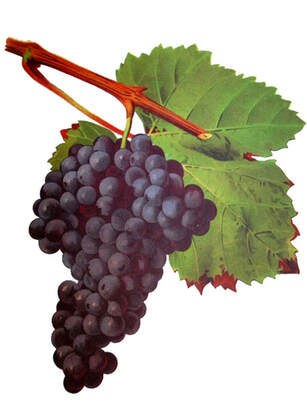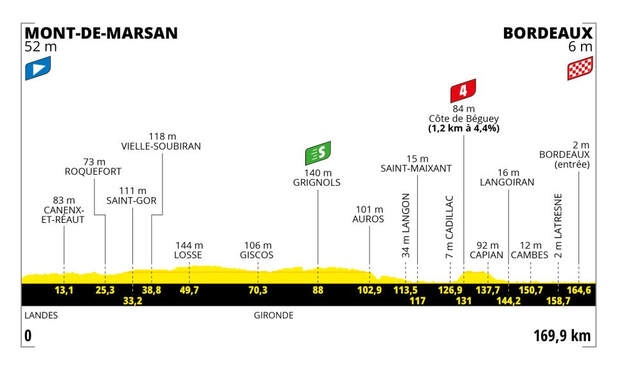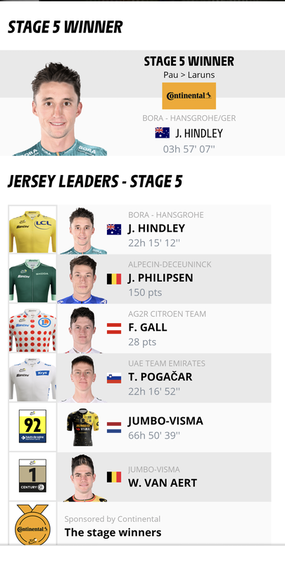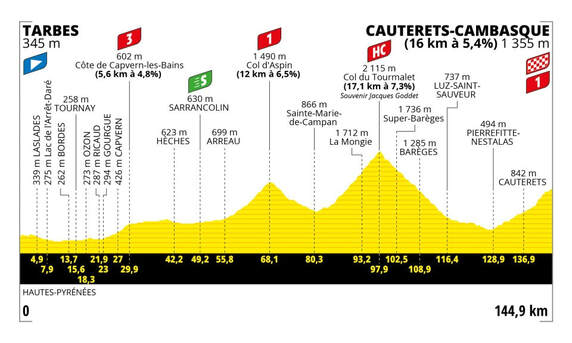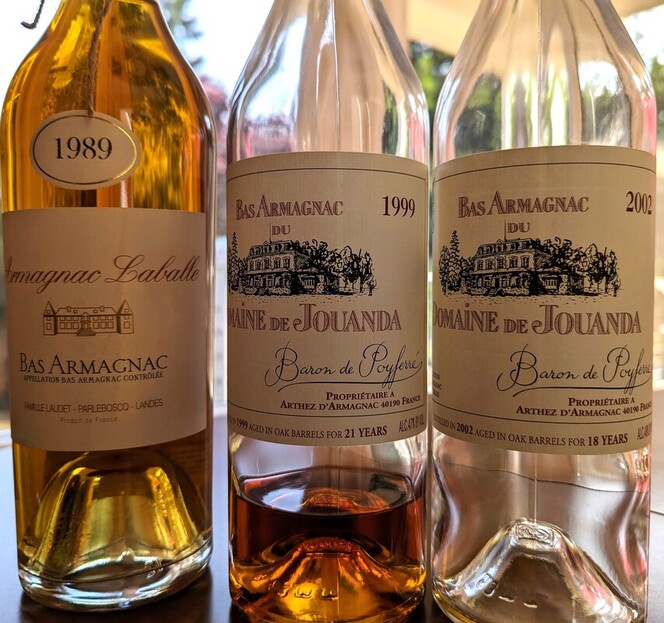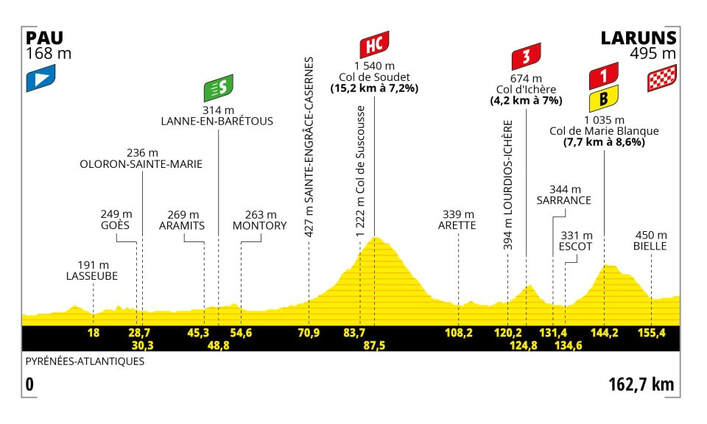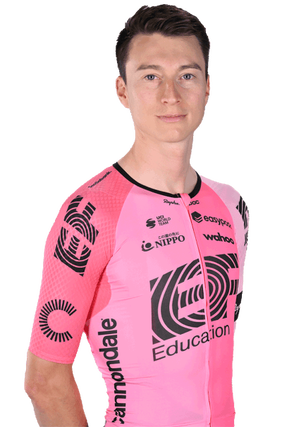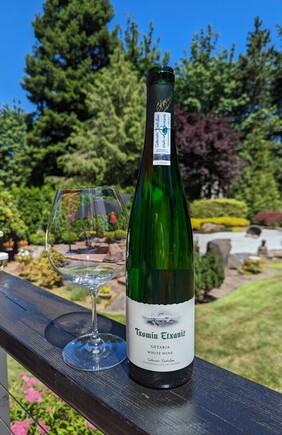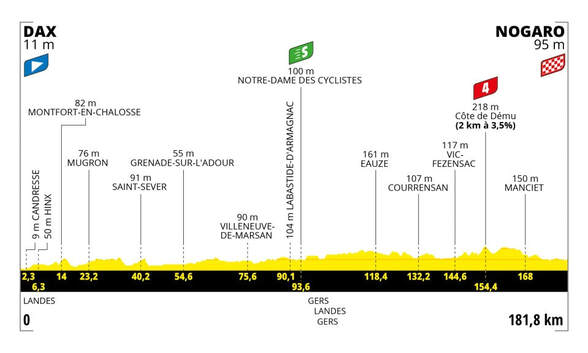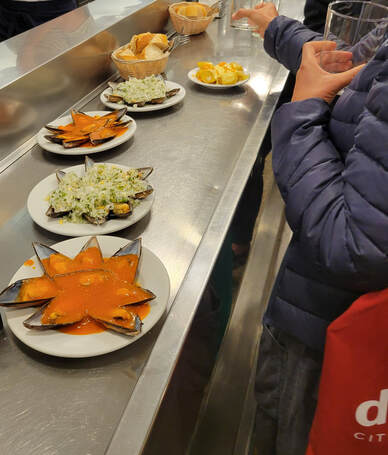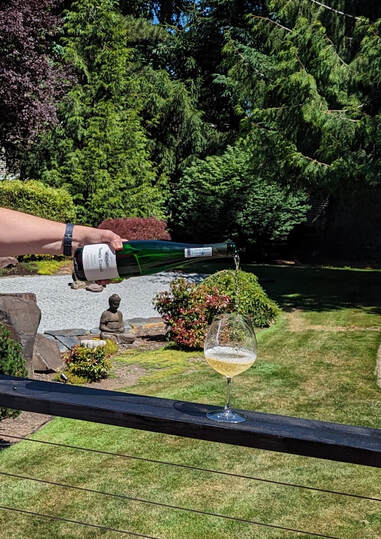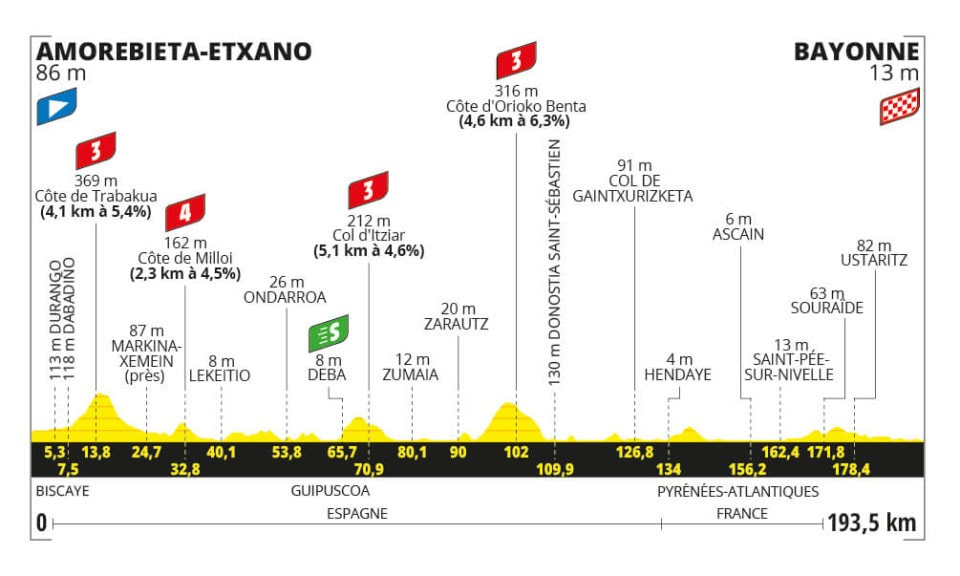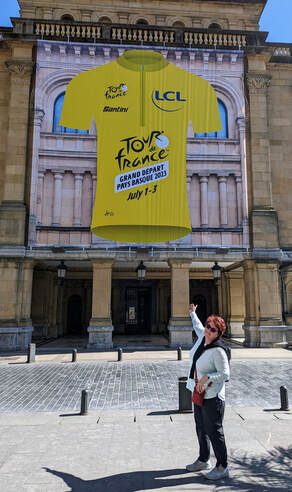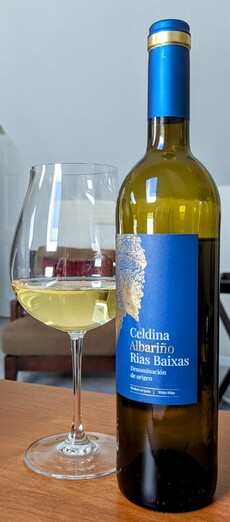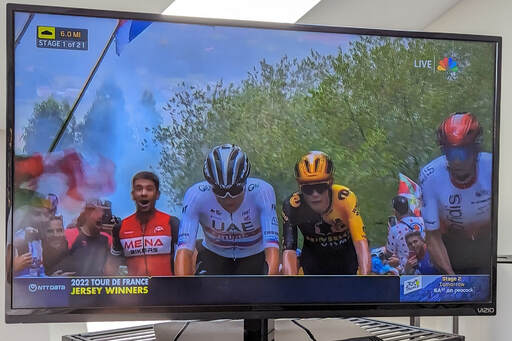|
THE WINE The Tannat grape variety is native to the rugged area in the foothills of the Pyrenees, where Stage 6 of the Tour de France begins today. The village of Madiran in the rolling countryside of Gascony, is an area known for its indulgent gastronomy and rich, concentrated, robust red wines. These wines are made primarily from the Tannat grape variety. Wines made from Tannat are structured with intense color, acidity, and tannins. Some wines are single-varietal wines, but Tannat can be blended with Cabernet Sauvignon or Cabernet Franc. Gascon culinary specialties include magret de canard and cassoulet – rich, gamey foods that demand a wine match of serious character and structure. Tannat prices are very reasonable, the wine is delicious; I hope you will try a Tannat wine. Today, Stage 6, the peloton races into the final stage in the Pyrenees mountains. These are some of the most storied climbs in the Tour de France.
Up into the mountains went the peloton, at about 68 km, over the Col d’Aspin Nelson Powless takes the intermediate King of the Mountain (KOA) points to go into the virtual lead for the Polka-dot Jersey. Mathieu Van Der Poel leads a very fast descent, clocked at about 40-45mph; with Wout Van Aert leading the 1st group through the valley up one of the most storied climbs, the Col de Tourmalet. 86 times the Col de Tourmalet has been part of the Tour de France. At about 3.5km to go on the climb, the team Jumbo-Visma accelerates with Vingegaard and Pogacar, team UAE, in the group. All riders are under pressure with the high race tempo. Brutal. American riders Sepp Kuss (Jumbo-Visma) and Neilson Powless (EF Education) are major players on these climbs. There are only 9 American riders in the race, so this is an unusual statement. The race favorites take off; Vingegaard with Pogacar on his wheel. With about 2km left in the race, Pogacar finds his extra gear and accelerates leaving Vingegaard behind. Pogacar wins the stage, with Vingegaard taking the Yellow Jersey. The entire top 10 was shuffled today. Neilson Powless took the 8 points at the top of the Col de Tourmalet to retake the Polka-dot Jersey and Jasper Philipsen remains in the Green Jersey. The last 2 stages in the Pyrenees were very exciting. Tomorrow, we will head north through Bordeaux; racing through the most famous vineyards in the most famous Grand Tour race. Sante THE WINE Jurançon is the wine region in the foothills of the Pyrenees mountains just southwest of Pau, on the left bank of the Gave de Pau/Ousse river which runs south of the city towards the Adour before flowing out to the Atlantic Ocean near Bayonne. The eponymous town (and commune) of Jurançon lies immediately across the Ousse from Pau. Grapes have been grown here since the 1400s. Today, Jurançon makes dry whites (Jurançon sec), sweet wines, and late-harvest sweet wines. Officially, Jurançon Sec must contain no more than four grams per liter (g/L) of sugar while Jurançon (sweet) must have a minimum residual sugar level of 40g/L and Jurançon Vendanges Tardives (Late-Harvest) a minimum of 55g/L. Natural sugar which remains in a wine after alcoholic fermentation is called residual sugar. Sugar is not added to the wine; the winemaker stops alcoholic fermentation when the residual sugars are at the proper levels. Jurançon wines have higher levels of acidity balancing the residual sugars of the intense golden-hued wines. Young wines have intensely floral and fruity aromas, while more aged wines can have aromas of gingerbread, dried fruits, and spices. These are lovely dessert wines. The prices for these wines are wide-ranging. Try this when you are looking for a special occasion wine. You can purchase these wines at many local shops, often in 375ml bottles (1/2 bottle) as well as, full-sized 750ml bottles. THE RACE; Stage 5 As I said yesterday, today is a big climbing day. After relaxing yesterday, the riders took off from the start this morning. There was a large breakaway; 37 riders went up the road. It took a long time for that large group to split into 2 groups but remained 4+ minutes ahead of the peloton. At 22km left, the peloton had made up 2 minutes on the lead group. Pogacar and Vingegaard were in the second group all day, until 19 km to go, Vingegaard took off and Pogacar could not respond, he was out of the high-octane gas late in the today. The Col de Marie Blanque mountain climb blew apart the top of the race rankings. Vingegaard accelerated leaving Sepp Kuss (USA) and Pogacar behind. Vingegaard took off to close the distance with the chase group during the descent. Jai Hindley (AUS) remained ahead of Vingegaard’s group, and Hindley won the stage. The race standings changed substantially today. Tomorrow will be another day of climbing in the Pyrenees. We will see who has legs to climb after stage 5. I will be writing about wine from Madiran wine region.
~ Sante 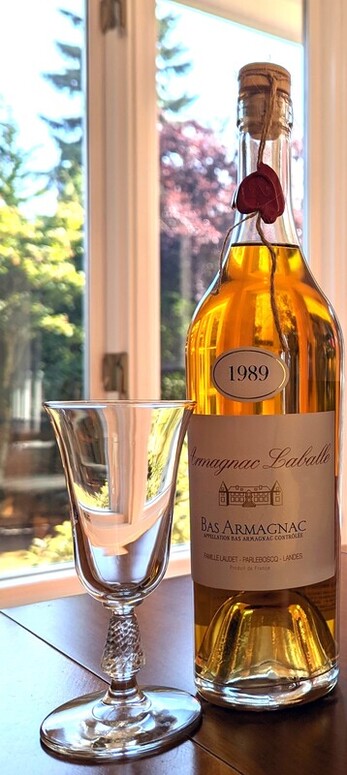 Armagnac Laballe, 1989 with glass. by Lisa Kolick Armagnac Laballe, 1989 with glass. by Lisa Kolick Today, I am writing about Armagnac, a wonderful spirit distilled from wine. You may not be familiar with Armagnac, but I am sure you have heard of and most likely tasted Cognac. Armagnac and Cognac are in the wine family, as they are both spirits distilled from wine. I have included quite a bit more information about Armagnac, as it is not made like a typical wine. Today’s race was somewhat of a “leisurely” pace to a fast sprint finish race. The last 10km of Stage 4 was the real race today. More on the race below. How Armagnac is made According to Wine-Searcher.com, Armagnac is made by distilling wine made from primarily Ugni Blanc, about 55%; typically accompanied by Folle Blanche, Baco Blanc , and Colombard grape varieties. Each of these brings its own particular qualities to the spirit, so the varieties are sometimes harvested, vinified, distilled, and aged separately. This gives producers greater freedom and flexibility when creating their final blend. This blend of spirits is then transferred back into barrel, where it homogenizes and is (if necessary) diluted gradually to bottling strength (typically between 40-45 percent). Because alcohol evaporates gradually over time in barrel, the longer a spirit is aged, the less dilution it requires. Quality grading and styles All Armagnacs are assigned a quality level, based on how much time the spirit spent in barrel: VS (between 1 and 3 years), VSOP (between 4 and 9 years), Napolean (between 6 and 9 years) and XO (10 years+). Some are marked with a specific age (that of the youngest spirit in the blend). Vintage-marked Armagnacs are produced exclusively from the stated vintage. Armagnac compared to Cognac The two most obvious differences between Armagnac and Cognac are region of origin and flavor profile. Armagnac comes from Gascony, 75 miles (120km) southeast of Bordeaux. Cognac comes from the Charente, 60 miles (100km) north of Bordeaux. Armagnac is more deeply flavored, weightier, earthier and darker. Cognac is slightly lighter, finer and fruitier. Beyond region and style, there are a few less obvious ways in which Armagnac and Cognac differ. The most technical of these is that most Armagnac is distilled just once, in a continuous still. This single distillation creates a heavier spirit – lower in alcohol and higher in flavor than Cognac (which is distilled twice in a traditional pot still). Because the distillation process naturally separates the spirit from its heavier flavor compounds, the less refined a spirit is, the richer its flavor. Most Armagnac leaves the still between 53 percent and 60 percent ABV (alcohol by volume), versus Cognac's 72 percent ABV. Below are vintage Armagnacs: 1989, 1999, and 2002, that were aged in oak barrels until they were bottled in 2020. They have deep flavors and drink very smoothly, even the newest vintage 2002. All of these examples are considered XO grade Armagnacs. Keep tasting wines you have not tried before. I hope you will be surprised by what you find. Now for today’s race-Stage 4 After 3 days of intense racing, the riders raced a relatively flat stage over 181km from Dax to Nogaro, in southwest France. The race passed through kilometers of vineyards and agricultural land. The riders rode at a “leisurely” pace of approximately 20-25 mph for most of the race. There were no breakaways until the conclusion of the intermediate sprint at 88km to go in the race. Jasper Philipsen took the points for the sprint. Then most riders settled in for the rest of the race. There was a breakaway by 2 riders following the sprint, but the peloton caught them well before the last 20km. The big sprint teams had control of the peloton for the last half of the race and kept the speed down to reserve energy for the sprinters at the finish of the race. The excitement was building for the last 5km of the stage. The sprint teams set up to launch their sprinters, then 3 crashes in the last 2km and the finish was a little wild. Speed and proximity to other riders make sprints exciting and dangerous. Jasper Philipsen edged out Caleb Ewing by half a bike tire to win the stage and take the points. Philipsen of team ALPECIN-DECEUNINCK took 2 for 2 sprints today. Mark Cavendish finished 5th on the day. He is getting closer to his record-setting stage win, but this will have to wait until Stage 7 when there is another flat stage from MONT-DE-MARSAN > BORDEAUX. Tomorrow the race heads to the Pyrenees mountains for the next 2 stages. These will be much bigger climbs than we have seen in the first three days of climbing, Stages 1-3 were merely hilly.
Santé STAGE 3 AMOREBIETA-ETXANO>BAYONNE, 193.5km On the way to France The race starts in Amorebieta-Etxano in the Spanish Basque; up the hills, around the twists and turns, back through San Sebastian along the narrow roads, through beautiful towns along the Atlantic coast of the Basque Region of Spain and France, on to the finish in Bayonne, France. The race will cross from Spain to France with about 50 km left in the race. The countryside has been gorgeous these first 3 days of the 2023 Tour de France. Phil Ligget, NBC commentator highlighted it as, “… the race has been a moving postcard.” Check out the On the Road with the Tour section on the Tour website. The race has not disappointed either, I think the riders have been phenomenal. Congratulations to Neilson Powless, currently wearing the polka-dot jersey as King of the Mountains. He has led the race during the first 3 days for an extraordinary 170km and has finished 1st on 9 of 11 mountain climbs. Spectacular ride Neilson Powless! More about Stage 3 below or go to the Tour website. THE WINE Today I am continuing to drink Txakolina, THE wine of the Basque regions of Spain and France. The sea, the mountains, and the climate grow grapes that ripen with great acidity and flavors of ripe lemons with a sense of salinity. That all explains why these wines are fantastic with local seafood, cheese, and stews, or food from the Pacific Northwest of the US. Grapes have grown in the Basque region since at least the 1300s. As with many old wine-growing regions, vineyards have shrunk and then revived over time. In Getaria the restoration began in the 1980s. You can see a beautiful picture of the village at about 86.4 km of the Tour. The riders raced around the edge of this picturesque fishing village, home to the DO Getariako Txakolina, the organization protects and represents the painstaking work of the family-owned wineries that create Getariako Txakolina. THE RACE The race was “like a rest day” after the riders got through the first 90km, which included significant climbs. Neilson Powless, Team EF Education, and Laurent Pichon, Team Arkéa, lead from early on until the last climb when Powless took the points and dropped back. Pichon continued on his own until the peloton caught him with about 37km left in the stage. The last 100km were somewhat “easy”. Sprinters were able to restore their energy and get ready for the last 20km and the sprint, which begins to set up with 3km to go. The sprint finish was a hotly contested, elbows-out, classic bunch sprint with Jasper Philipsen winning the stage. Mark Cavendish finished 6th today, still in search of his 35th stage win in the Tour de France. Stage 4 begins in Dax, France, and finishes in Nogaro, France; 182km flat stage. The race is now in France until the finish. Stage 4 is expected to be fast with a faster finish on the Circuit Paul Armagnac, in Nogaro, France.
Join me tomorrow, I will be writing about Armagnac; a brandy distilled from wine made with a blend of white grapes from Gascony in southwest France. Santé STAGE 2 VITORIA-GASTEIZ finishing in SAINT-SÉBASTIEN 209 KM, a hilly stage. THE WINE Today the race left from Vitoria-Gasteiz, the capital of the Autonomous Basque Region. Along this stage we will explore the quintessential wine of the Basque region, Txakolina (Chock-oh-LEE-nah). The wines of the region are born of vineyards between the sea and mountains. On the race route we have seen vineyards at various places, with a lovely picture at the 100 km mark of the race. The Basque region is hot and humid with the wind blowing off the sea, keeping grapes ripe with acidity. The grapes grown and used to produce Txakolina are native to the Basque region: Hondarrabi Zuri and Hondarrabi Beltza, but Bordeleza Zuria (Folle Blanche), Izkiriota Ttipia (Petit Manseng) and Izkiriota (Gros Manseng) are also permitted. 90% of the wines are white wines, with the remainder rosé and a bit of red wine. The white wines produced for Txakolina are light, racy, slightly effervescent delicious wines that pair wonderfully with the local fare: seafood, rustic stews, and Pintxo (tapas) of all sorts. I am lucky to have had the pleasure of experiencing Txakolina in Donostia-San Sebastian, with Pintxo (tapas). This 2021 Etxaniz Getariako Txakolina (Chock-oh-LEE-nah) for Stage 2, reminds me of pintxo of mussels or fresh anchovy and tuna. This is a wine of designated origin, DO-DO Getariako Txakolina. There are 2 other DOs in the Basque region: DO Bizkaiko Txakolina and DO Arabako Txakolina. These are wines of place. Txakolina is slightly effervescent, the best way to pour this wine is to hold the bottle high above the glass and pour. This aerates the wine and the bubbles release the aromas. Bubbly aromas of lemon and sweet herbal; with racy acidity and effervescence being the first things I notice with my first sip. Perfect for race day, lemon citrus fills my mouth, as the flavors dissipate on my mid-palate, I am left with mouthwatering acidity. This is a straightforward wine that is delicious with all of the food in the Basque region, but also with the oysters and seafood of the Pacific Northwest of the US. Check out this article by NY Times wine writer, Eric Asimov, Txakolina, a Simple Pleasure With a Deep Sense of Place.
THE RACE Stage 2 of the 2023 Tour de France starts with only 174 riders, as Richard Carapaz, Team EF Education EasyPost, and Enric Mas, Team Movistar did not start. Both were injured in the last 20 km of Stage 1. Carapaz powered through to the finish with a fractured knee cap and a wound needing stitches. VITORIA-GASTEIZ finishing in SAINT-SÉBASTIEN 209 KM, is a hilly, technical stage, similar to Stage 1. Click here for a race summary of the longest stage in the 2023 Tour de France. The race was very fast. Early in the stage the peloton was averaging over 50 Kph. Three riders lead a breakaway early on and kept their lead until the last 20 km. Pogacar won the bonus point atop the Jaizkibel before Vingegaard while Simon Yates went over in third position. Then, the race was on to the finish. Teams raced off the descent for the sprint to the finish. LaFay made a massive acceleration in the last 1000km to take the lead and win the stage. Standings at end of day: Stage Winner:Victor LaFay, Team Cofidis Yellow Jersey (overall race leader): Adam Yates, Team UAE Green Jersey (sprint leader by points): Victor LaFay, Team Cofidis Polka Dot Jersey (king of the mountains by points): Neilson Powless, Team EF Education EasyPost White Jersey (best young rider by points): Tadje Pogacar, Team UAE Team: Jumbo-Visma Most Aggressive Rider of the Day: Neilson Powless, Team EF Education EasyPost STAGE 3 The first 2 days of this year’s Tour were some of the toughest in the history of the race. Tomorrow is a somewhat flatter stage: AMOREBIETA-ETXANO > BAYONNE, 185 KM, as we head into France. This stage should help the sprinters who have been hauling themselves over many difficult “hills”, which are not their terrain of choice. We are still drinking Txakolina as we go into the French Basque region of Southwest France. Santé Stage 1- Bilbao to Bilbao, 182km of hilly, winding, narrow roads. The excitement of the start of the 110th Tour de France called for a crisp, lively white wine. I chose Celdina Albarino, 2021. This is a dry white wine from Rias Baixas,DO, Galicia Spain, west of Bilbao. Albarino is crisp and dry with aromas of ripe stone fruits and herbal notes such as tarragon. On the palate, there is bright acidity leading the way to flavors of ripe peach, ripe citrus, and a mouth-filling finish. Albarino is widely available for purchase, throughout the US and Europe. Enjoy this wine chilled or create an amazing white sangria with peaches and apples to enjoy with summertime fare, such as seafood, goat cheese appetizers, or roasted chicken. Albarino is usually a great value with a price that makes it easy to try something different. Today’s race was a very challenging to start the 2023 Tour de France. The racing was full-on from the start. The race coverage was good and showed the beautiful green forests and towns while capturing most of the action. Several notable riders are out and injured due to a crash around 161km of the race: Enric Mas (Spanish rider) from Movistar (Spanish team) abandoned the race and Richard Carapaz (Ecuadorian rider and national champion) EF Education/EasyPost, was injured in the same crash. Carapaz finished the day, but we are not sure if he will start tomorrow. The race favorites Pogacar and Vingegaard raced over the final climb of the day, together. On the descent, Pogacar accelerated with a small group to push ahead. Twin brothers, riding for different teams, went out ahead race and finished with Adam Yates (UAE team) winning, Simon Yates (Jayco-Alula) second, and Tadej Pogacar (UAE team) third. Vingegaard and his team Jumbo-Visma finished just behind the lead group. See all of today’s final standings here. Stage 2: VITORIA-GASTEIZ to DONOSTIA- SAN-SÉBASTIEN 209 KM of terrain similar to Stage 1. They call it hilly, but these are substantial hills with twists and turns that are fast and technical. It is sure to be another exciting race. So, I have chosen 2021 Etxaniz Getariako Txakolina (Chock-oh-LEE-nah) for this exciting stage. Txakoli is a wonderful style of wine widely available at Total Wine. Txakoli is the wine of the Basque and pairs well with all the seafood, cheese, and stews the Spanish Basque region has to offer. Santé |
|
© Grapes and Still Waters, 2019-2023
We do not sell or share your information.
We do not sell or share your information.
